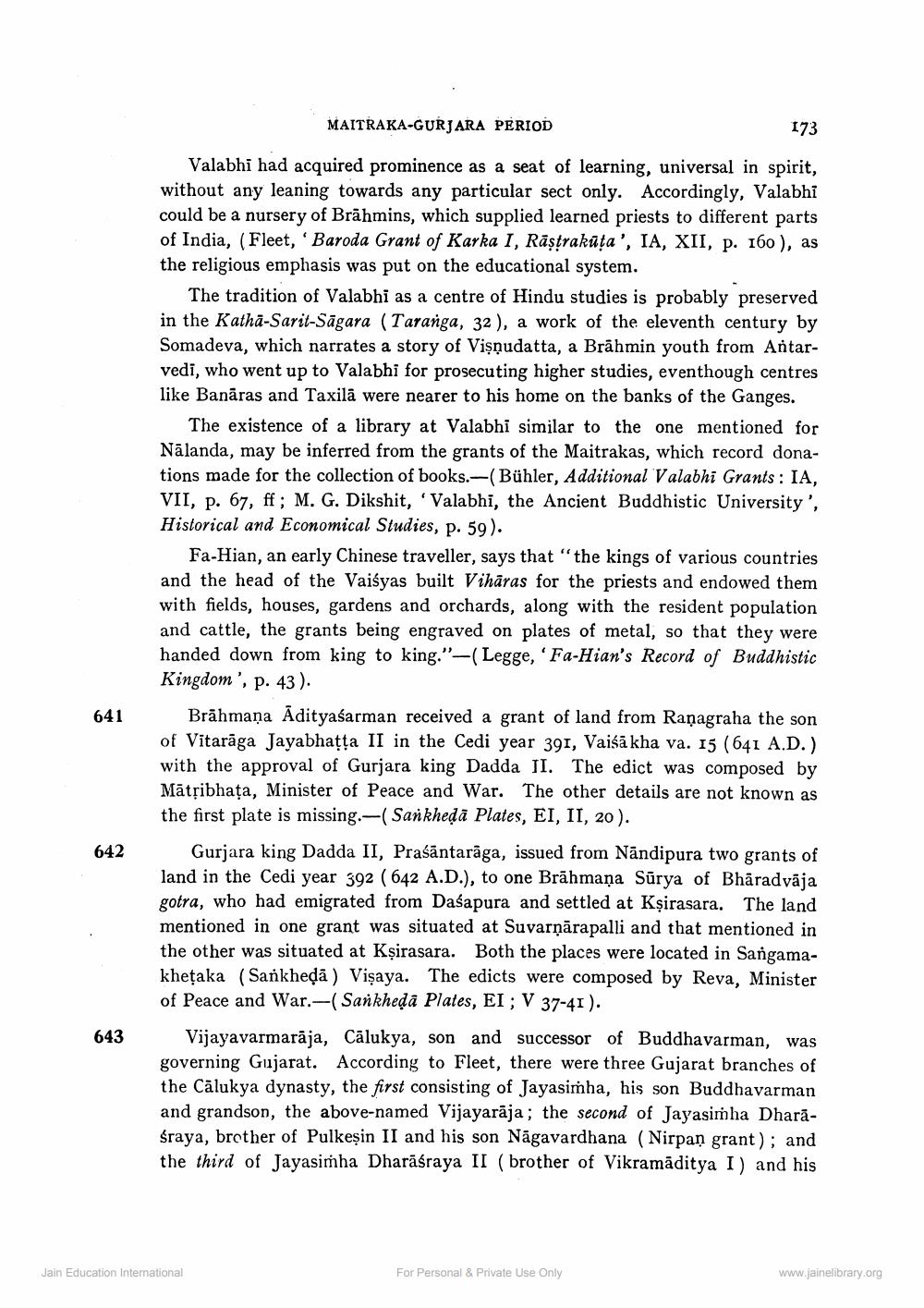________________
MAITRAKA-GURJARA PERIOD
173
Valabhi had acquired prominence as a seat of learning, universal in spirit, without any leaning towards any particular sect only. Accordingly, Valabhi could be a nursery of Brāhmins, which supplied learned priests to different parts of India, (Fleet, ‘Baroda Grant of Karka I, Rāştrakūta', IA, XII, p. 160), as the religious emphasis was put on the educational system.
The tradition of Valabhi as a centre of Hindu studies is probably preserved in the Kathā-Sarit-Sāgara (Taranga, 32 ), a work of the eleventh century by Somadeva, which narrates a story of Vişnudatta, a Brāhmin youth from Antarvedi, who went up to Valabhi for prosecuting higher studies, eventhough centres like Banāras and Taxila were nearer to his home on the banks of the Ganges.
The existence of a library at Valabhi similar to the one mentioned for Nālanda, may be inferred from the grants of the Maitrakas, which record donations made for the collection of books.-(Bühler, Additional Valabhi Grants : IA, VII, p. 67, ff; M. G. Dikshit, Valabhi, the Ancient Buddhistic University', Historical and Economical Studies, p. 59).
Fa-Hian, an early Chinese traveller, says that "the kings of various countries and the head of the Vaisyas built Vihāras for the priests and endowed them with fields, houses, gardens and orchards, along with the resident population and cattle, the grants being engraved on plates of metal, so that they were handed down from king to king."-(Legge,' Fa-Hian's Record of Buddhistic Kingdom', p. 43).
Brāhmaṇa Adityaśarman received a grant of land from Raņagraha the son of Vitarāga Jayabhatta II in the Cedi year 391, Vaisakha va. 15 (641 A.D.) with the approval of Gurjara king Dadda II. The edict was composed by Mātņibhața, Minister of Peace and War. The other details are not known as the first plate is missing.-(Sankheļā Plates, EI, II, 20).
Gurjara king Dadda II, Praśāntarāga, issued from Nandipura two grants of land in the Cedi year 392 ( 642 A.D.), to one Brāhmaṇa Sūrya of Bhāradvāja gotra, who had emigrated from Daśapura and settled at Kșirasara. The land mentioned in one grant was situated at Suvarṇārapalli and that mentioned in the other was situated at Kșirasara. Both the places were located in Sangamakhețaka (Sankheda ) Vişaya. The edicts were composed by Reva, Minister of Peace and War.-(Sankheda Plates, EI ; V 37-41 ).
641
642
643
Vijayavarmarāja, Cālukya, son and successor of Buddhavarman, was governing Gujarat. According to Fleet, there were three Gujarat branches of the Cālukya dynasty, the first consisting of Jayasimha, his son Buddhavarman and grandson, the above-named Vijayarāja; the second of Jayasimha Dharāsraya, brother of Pulkesin II and his son Nāgavardhana (Nirpan grant); and the third of Jayasimha Dharāśraya II (brother of Vikramāditya I) and his
Jain Education Interational
For Personal & Private Use Only
www.jainelibrary.org




